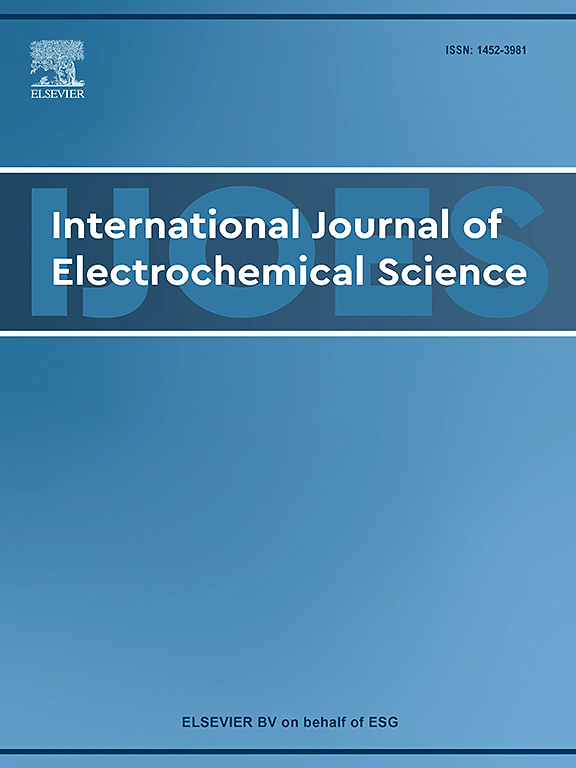Speciation analysis of Sb(III) and Sb(V) by adsorptive stripping voltammetry in the presence of Pyrogallol red
IF 2.4
4区 化学
Q4 ELECTROCHEMISTRY
International Journal of Electrochemical Science
Pub Date : 2025-07-05
DOI:10.1016/j.ijoes.2025.101120
引用次数: 0
Abstract
This work presents an adsorptive stripping voltammetric method for the speciation of antimony based on the formation of their complexes with Pyrogallol red (PGR). Both Sb(III) and Sb(V) form complexes with PGR, however Sb(III) forms complex rapidly whereas Sb(V) forms complex very slowly. After the SbV-PGR complex is formed, on the surface of the mercury electrode is reduced to SbIII-PGR. Then the electrochemical signal is the reduction of SbIII-PGR complex to Sb(0). The variation of peak current with pH, accumulation time (tacc), accumulation potential (Eacc), and PGR concentration (CPGR) were optimized. The best experimental conditions for Sb(III) were pH: 2.2 (0.1 mol L−1, Phosphate buffer, PB), CPGR: 3.0 μmol L−1, and Eacc: −0.10 V obtaining a detection limit (DL) of 1.1 μg L−1 (tacc: 35 s). When measured at 2 h, the signal of the SbIII-PGR complex is almost the same and now it is possible to appreciate the increase in the signal due to presence of SbV-PGR complex, previously reduced to SbIII-PGR in the Hg electrode. This allows us to determine the total concentration of antimony. The developed method was validated by the determination of Sb(III) in spiked drinking water from the laboratory and spiked synthetic seawater with relative errors of less than 5.0 %. The method was successfully applied to the determination of Sb(III) and Sbtotal in an Industrial waste liquid sample comparing the results of Sbtotal by ICP-OES technique (RE: 0.6 %).
邻苯三酚红存在下吸附溶出伏安法分析Sb(III)和Sb(V)的形态
本文提出了一种吸附溶出伏安法,根据锑与邻苯三酚红(PGR)络合物的形成来测定锑的形态。Sb(III)和Sb(V)均与PGR形成配合物,但Sb(III)形成配合物速度快,Sb(V)形成配合物速度慢。SbV-PGR络合物形成后,汞电极表面还原为SbIII-PGR。电化学信号为SbIII-PGR络合物还原为Sb(0)。优化了峰值电流随pH、积累时间(tacc)、积累电位(Eacc)和PGR浓度(CPGR)的变化规律。Sb(III)的最佳实验条件为pH: 2.2(0.1 mol L−1,磷酸缓冲液,PB), CPGR: 3.0 μmol L−1,Eacc:−0.10 V,检出限为1.1 μmol L−1 (tacc: 35 s)。当在2 h下测量时,SbIII-PGR复合物的信号几乎相同,现在可以体会到由于SbV-PGR复合物的存在而增加的信号,SbV-PGR复合物之前在Hg电极中还原为SbIII-PGR。这使我们能够测定锑的总浓度。通过实验室加标饮用水和人工加标海水中Sb(III)的测定,验证了该方法的有效性,相对误差小于5.0 %。该方法成功地应用于某工业废液样品中Sb(III)和Sbtotal的测定,并与ICP-OES法测定Sbtotal的结果进行比较(RE: 0.6 %)。
本文章由计算机程序翻译,如有差异,请以英文原文为准。
求助全文
约1分钟内获得全文
求助全文
来源期刊
CiteScore
3.00
自引率
20.00%
发文量
714
审稿时长
2.6 months
期刊介绍:
International Journal of Electrochemical Science is a peer-reviewed, open access journal that publishes original research articles, short communications as well as review articles in all areas of electrochemistry: Scope - Theoretical and Computational Electrochemistry - Processes on Electrodes - Electroanalytical Chemistry and Sensor Science - Corrosion - Electrochemical Energy Conversion and Storage - Electrochemical Engineering - Coatings - Electrochemical Synthesis - Bioelectrochemistry - Molecular Electrochemistry

 求助内容:
求助内容: 应助结果提醒方式:
应助结果提醒方式:


